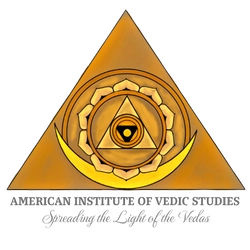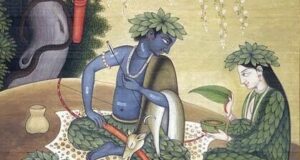By Vamadeva Shastri (David Frawley)
Yoga and Ayurveda are vast topics, particularly when one considers both their traditional and modern developments, and the great variety of topics and practices that each can cover. Yoga is not just asanas and Ayurveda is not just herbs, however important these may be! They cover the whole of life.
Both Yoga and Ayurveda are historically closely related and have developed in parallel since ancient times. They have diverged in modern times, over the last hundred and fifty years, particularly outside of India, in which Yoga without Ayurveda was for a long time the norm. However, Yoga and Ayurveda are becoming reconnected again, not only in India but throughout the entire world. Their reintegration is the reintegration of consciousness, life, healing and transformation!
Origins of Yoga and Ayurveda
Yoga begins historically with the Mantra Yoga of the Rigveda, the oldest Vedic textthat originated over five thousand years ago. These mantras of the Rishis promote a Yoga or union with the higher powers of consciousness in the universe, providing the basis for the Self-knowledge and cosmic knowledge that we find in later Vedanta and the Vedic sciences.
This connection of Yoga and mantra is reflected in the Yoga Sutras of Patanjali that emphasizes OM, the main mantra from which the Vedas are said to have originated, and in Patanjali’s work as great grammarian.
Vedic mantras, along with corresponding rituals and meditations, were commonly used both for spiritual development and for helping gain the outer goals of life, invoking the Devatas or the Divine powers behind nature and the soul. These cosmic energiesare defined mainly as four in the Vedas as Agni (fire), Vayu or Indra (air and electrical energy), Surya (sun) and Soma (moon). Their light forms are symbolic of yet deeper inner powers of Agni as speech, Vayu/Indra as Prana, Surya as Atman (soul), and Soma as the mind. A variety of such formulations exists in Vedic texts.
Veda means knowledge or science and Yoga, meaning work or practice, arose as a term for its application. Veda or true knowledge implies Yoga or the work of integration with the greater conscious universe.
Ayurveda arose in the Vedic context as the Upaveda or supplementary Vedic text that focused on healing and well-being for both body and mind. Ayurveda first arose as an application of Vedic mantras, not as a separate discipline. All Vedic teachings have a potential Ayurvedic or healing application, especially Vedic rituals and mantras. Many Vedic practices are said to grant ‘sarvayur’, meaning not only longevity but the fullness of life, as one of their primary goals. They are still used in this manner today. Healing and longevity are considered to be natural results of Vedic practices, with someVedic practices specifically related to these.
Ayurveda is usually considered to be a branch of the Atharva Veda, which contains the most mantras aimed specifically at healing. However, aspects of Ayurveda can be found in all the Vedas and are inherent in the Vedic deities (Devatas) and in the Vedic cosmology.
‘Vedic Yoga’, such as we find in the Svetsvatara Upanishad, emphasized how the Vedic Devatas or cosmic energies like Agni, Vayu and Soma work in the psyche as forces of internal integration and self-realization.
Note the following versesSvetasvatara Upanishad II.6,8:
Where the Agni (fire) is enkindled, where Vayu (the wind) is controlled, where Soma overflows, there the mind is born.
This is perhaps the key verse that helps us understand the yogic and Ayurvedic implications of the main Vedic deities. Here Agni, Vayu and Soma, the great Vedic deities of Fire, Air and the Moon refer to their internal counterparts of will, prana and mind and are indicative of the practice of Yoga. The Fire is the Kundalini fire. Control of wind refers to Pranayama. Soma here is the bliss of meditation or samadhi. In these the higher mind or consciousness is born.
Making straight the three places, balancing the body, merge the senses along with the mind into the heart, by the boat of Brahman the knower should cross over all the channels that bring us fear.
The three places are the navel, heart and head, indicating a straight spine, usually in a balanced sitting pose. The channels that bring us fear are the nadis of the subtle body that keep our energy caught in duality, particularly the lunar and solar or Ida and Pingala nadis.
Ayurveda takes the same Vedic Devatas and looks at them at a biological angle with Agni as Pitta Dosha, Vayu as Vata Dosha, and Soma as Kapha dosha.
This means that both Yoga and Ayurveda arose as complimentary applications of the same universal forces, which they both help us connect to.
Yoga became eventually more defined as one of the six darshanas or six systems of Vedic philosophy, the systems that accepted the authority of the Vedas. Yet this is Yoga as a special system, while different aspects of Yoga pervade all Vedic teachings and darshanas.
Yoga emerged in more specificity in texts like the Bhagavad Gita and the Mahabharata of which the Gitaispart, which covers the topic Yoga of in many various forms. The MB mentions not just the Yoga Darshana or Samkhya-Yoga, but also Shaivite Yoga called Pashupata Yoga, and Vaishnava Yoga. These were interrelated but had their differences. Yoga as Samkhya-Yoga was said to be the system initiated by Hiranyagarbha, passed on to the Rishi Vasishta. Patanjali is not yet mentioned.Ayurveda is also mentioned in the Mahabharata, as well as Vedic astrology. As stemming from Dhanvantari, an avatar of Vishnu, Ayurveda often has marks of Vaishnava thought.
Later specific texts for these different systems emerged, with Charak and Sushrut Samhitas for Ayurveda and Patanjali’s Yoga Sutras for Yoga. Many other such early texts probably existed that were lost through time, and they were followed by a proliferation of divergent teachings and commentaries. Curiously in terms of language and culture, Charak and Sushrut Samhitas, one should note, appearlargely earlier than Patanjali, though they mention Yoga. However, compilations like Charak and Sushrut reflect a labor of many centuries, and even Sutra works like the Yoga Sutras may have undergone slight changes over time.
The Shaivite yoga also continued to developed.This includedeventually the systems of Hatha Yoga and Siddha Yoga, which had its own Raja Yoga, as well as other Tantric Yoga systems. Much Ayurveda isthere in the Shaivite yoga as Shiva is the deity of Prana. This is the Ayurveda and Yoga of the Himalayas where Shiva is the prime deity.Vaishnava schools Yoga also continued to develop along devotional lines as in Narada’s Bhakti Yoga Sutras.
In all these expressions of Yoga and Ayurveda, we find a common language and philosophy. Yoga applied for health of body and mind reflects Ayurveda. Ayurveda applied for the development of higher awareness crosses over into Yoga.
Modern Yoga
Modern Yoga is a development of the last one hundred or more years that is global in nature. Though it began with the basis of classical Yoga and Vedanta through Swami Vivekananda at the turn of the twentieth century, and though this spiritual Yoga has continued to develop,most of modern Yoga has become progressively physical in nature. The main practice of Yoga has moved from the mantra and meditation of classical yoga primarily to asanas or Yoga postures. Yet this has also allowed Yoga to reach a much larger and more popular audience, and to broaden its base considerably, to every corner of the planet.
Modern Yoga consists primarily of group asana or public ‘yoga’ classes, rather than individualized sadhana or spiritual practiceas is the case with classical Yoga. It has entered the world of exercise, fitness and health, including gymnasiums, and become a progressively a bodily concern and expression.In this process modern Yoga has dialogued, influenced and been influenced by other modern trends in health and fitness, diet and exercise. Yet modern yoga retains some of the aura and practices of classical Yoga, extending at times to mantra and meditation, as well as chanting or kirtan, pranayama and Yoga nidra. Modern Yoga has created an entire Yogic culture of Yoga classes, Yoga retreats, Yoga vacations and Yoga intensives. Yet this is often connected to the traditional Yoga culture of ashrams, pilgrimage and special sadhanas.
Physical Versus Spiritual Yoga
Some people look at Yoga more for its physical benefits, others more for its spiritual benefits. Sometimes these two groups differ or even clash. Some physical Yogis call the spiritual Yoga something else, like devotion or meditation. Some spiritual Yogis call the physical Yoga, something else, like a mere fitness movement. Both use the Yoga word for what they do but have a different meaning for it, Yoga as Asana versus Yoga as Union with the Divine. Both types of Yoga of course can go together, and need not be contrasting views. Yet we should acknowledge the origins of Yoga more at a spiritual than a physical level. In any case there are several models of Yoga in the world today and we should allow each its place, though recognize that Yoga cannot be limited to any single group or definition.
Ayurveda’s view of Yoga combines it with treatment of both body and mind, affording it both physical and spiritual dimensions. Yet Ayurveda broadens the physical and health concerns of Yoga from exercise to overall life-style, diet and herbs, extending to the mind.
Yoga Therapy and Ayurveda
Modern Yoga as an exercise practice has created its own healing approach, which is usually called ‘Yoga therapy’. This modern Yoga therapy, though a highly diverse phenomenon, is usually a kind of physical therapy and used along with other physical manipulations and massage. It largely consists of using asanas to treat physical problems, diseases, or injuries, as a kind of adjunct physical therapy. Yoga asanas can be very helpful in this manner and their benefits can extend to all the systems and organs of the body. Sometimes we get the impression that there is a special signature asana for every disease, which can at least contribute to its cure!
When Yoga first came to the West and went global, Ayurveda did not come with it, perhaps owing to the fact that the British had closed down Ayurvedic schools during the colonial era, and Ayurveda was regarded as a backward and unscientific subject. The result of this long term trend is that many western Yoga groups have learned Yoga and Yogic healing apart from Ayurveda. Such modern Yogic healing has been a combination of yogic methods with modern methods of massage, physical healing, or even psychology. Some of modern Yoga therapy does not want to be connected with Ayurveda in any primary manner as it has already developed along its own lines. Yet in recent decades Ayurveda has come back into the Yoga world, starting a new dialogue, and a new possible integration of Ayurveda, not only with classical Yoga but also with modern Yoga.
The term Yoga therapy seems to imply that there is a special Yogic system of medicine in its own right, and that nothing else but Yoga may be required for health, wellness or the treatment of disease. Yet Yoga practice by itself, if we look at it carefully, is not a system of medicine but a form of treatment (Chikitsa), a set of healing activities. A system of medicine requires an understanding of how the body works,a system of diagnosis, and treatment methods of all kinds, including diet, herbs, and clinical procedures.
Actually there is no yogic system of medicine other than Ayurveda. If we take the prime principles of Yoga and Samkhya philosophy from Purusha and Prakriti or soul and nature, down to the sense and motor organs and five elements, and then add the factors of physical or bodily existence, we will arrive at the three doshas and seven dhatus of Ayurveda.The doshas manifest from Prana and the five elements.
Ayurveda is the physical counterpart of classical Yoga and provides the basis of a complete medical system in both theory and practice that reflects yogic point of view. This is what the ancient sages of India did. They developed Yoga for realizing a higher consciousness and Ayurveda for health and well-being.
Chikitsa proper or therapy is a topic of Ayurveda or a healing system, such as we find as a chapter heading in most Ayurvedic texts like Charak and Sushrut which have their Chikitsa Sthanas. Chikitsa or treatment rests upon Nidana or diagnosis, which Ayurveda also provides. Every Ayurvedic text has its section on Nidana. There is no classical Yoga Nidana apart from Ayurveda either. A yogic type of diagnosis would have to consider the pranas, Agni, the doshas and the other factors of Ayurveda. This means that Yoga Chikitsa was originally part of the Chikitsa approach of Ayurveda and may still work best along with it.
Traditional Yoga therapy is usually aligned with Ayurveda, such as we find in classical Yoga texts. Modern Yoga therapies may not be overtly so, but all can be brought into the scope of Ayurvedic considerations, with Ayurveda providing a point of integration for all healing therapies. For this we need to understand Yoga as a treatment and Ayurveda as a medical system.
Yogic and Ayurvedic Life-style
Ayurveda is not merely a medical system aimed at the treatment of disease, but a healthy and natural way of living, and of developing one’s highest potential in life. Ayurveda begins with right life-style, including daily and seasonal health regimens, designed for each individual based upon their nature, constitution, environment and life-circumstances.
Yoga alsobegins with a certain life-style, most commonly defined through the yamas and niyamas, the principles and practices of a yogic way of life. The eight limbs of classical Yoga form the practices of a higher life-style promoting prana, creativity, higher development of the senses, mind and awareness. They are helpful, if not essential for any higher well-being for the human being.
An Ayurvedic life-style implies Yoga or conscious living, and a yogic life-style implies Ayurveda and living in harmony both with nature and with one’s own nature. The two inherently go together.
What Ayurveda provides for Yoga
Ayurveda provides many benefits for enhancing Yoga practice. Yoga first of all requires adaptation at an individual level for its maximum efficacy. Ayurveda provides the principles of individualized adaptation primarily through its theory of the three Doshas of Vata, Pitta and Kapha.Knowing one’s doshic type helps one in the application of the Yoga practices, asanas, pranayamas and other factors. Ayurveda also helps us adapt diet, herbs and clinical practices to compliment our practice of Yoga. We could say that Ayurveda provides a basis for Yogic living or Yoga life, which is Yoga according to Ayus. Yoga/Ayus.
What Yoga provides for Ayurveda
The benefits of Yoga for Ayurveda are similarly enormous. Yoga provides for Ayurveda an entire line of life-style, physical, psychological and spiritual treatment measures that help bring out the higher dimension of Ayurveda.Not only does asana have tremendous healing benefits that need to be explored, so does pranayama.
We can call asana the external medicine of Yoga, much like external treatment measures in Ayurveda like massage that similarly works on the musculo-skeletal system. We can call pranayama the internal medicine of Yoga, much like the taking of herbs, which has a more primary effect upon the circulatory, nervous, respiratory and digestive systems. Pranayama helps us increase our energy and vitality and can help correct other pranic imbalances in the body and mind.
Pratyahara or Yogic relaxation aids in Ayurvedic healing, showing how we can draw in our mental, sensory and physical energy for rejuvenation. A good example of this is the practice of Yoga nidra.
Dharana or Yogic concentration is the main way to develop our intelligence, buddhi or prajna, so that we can avoid mistakes of judgment that can end up causing disease and suffering. Increasing our attention span, it can aid in our work and study, particularly in the computer age.
Meditation or dhyana is the sovereign way to take care of spiritual suffering, which is rooted in the disturbances of the mind.
Raja Yoga, which implies all eight limbs of Yoga, is particularly good for psychological ailments and also is a great aid for rejuvenation of both body and mind. That is why to practice Yoga effectively, one may need to remove the toxins or doshas of the body and mind through Pancha Karma.
Shadkarmas of Yoga and Pancha Karma of Ayurveda
Hatha Yoga offers its six detoxification methods or Shadkarma. These however can be harsh, particularly the swallowing of cloths. They are mainly for those who are young and strong. They can easily disturb Vata dosha and are hard to do. They can cause depletion for those who are older or weaker in constitution.
Ayurveda offers its five detoxification methods or Pancha Karma. These are based upon an individual diagnosis and a monitored treatment over an extended period of time. The doshas are systemically brought into the digestive tract for their removal. These methods are safer, better organized and arguably more effective than the Shadkarma. Of the Shadkarma methods, Neti, Trataka and strong Pranayamas are the safest.
Yoga and Ayurveda for Wholistic Living
The human being is a whole person, which extends to the entire mind, body and beyond. Even if we may somehow be physically limited or impaired, we still want to be treated like a whole person. This principle of wholeness is the Atman or Purusha, the higher Self that pervades and upholds both body and mind. It is that same consciousness principle that is the principle of wholeness in the world of nature and is responsible for the integrity of the ecosystem and the linking together of everything in the universe like a single organism.
Yoga begins with the principle of wholeness as establishing consciousness as the foundation of all that we do.Ayurveda recognizes the wholeness and integrity of body, mind and the natural world through the power of Prana.Wholistic living implies living in the wholeness of our own nature, which is linked to the wholeness of the entire universe.
A New Integration of Yoga and Ayurveda
A new integration of Yoga and Ayurveda must consider both the traditional and modern bases and applications of both systems. It should take an integral mind-body approach, and aim both at primary well-being and be capable of the treatment of specific diseases as well.Yet it begins with Yoga/Ayur or Yogic living, which is Ayurveda. This integration of Yoga and Ayurveda can revitalize each of these great Vedic sciences, and help humanity enter into a new era of healing. Yoga and Ayurveda can help us heal ourselves and our world, nature, mind and spirit.







